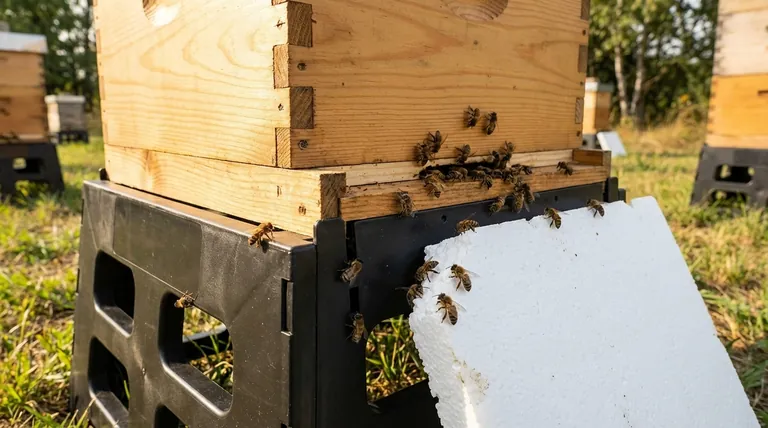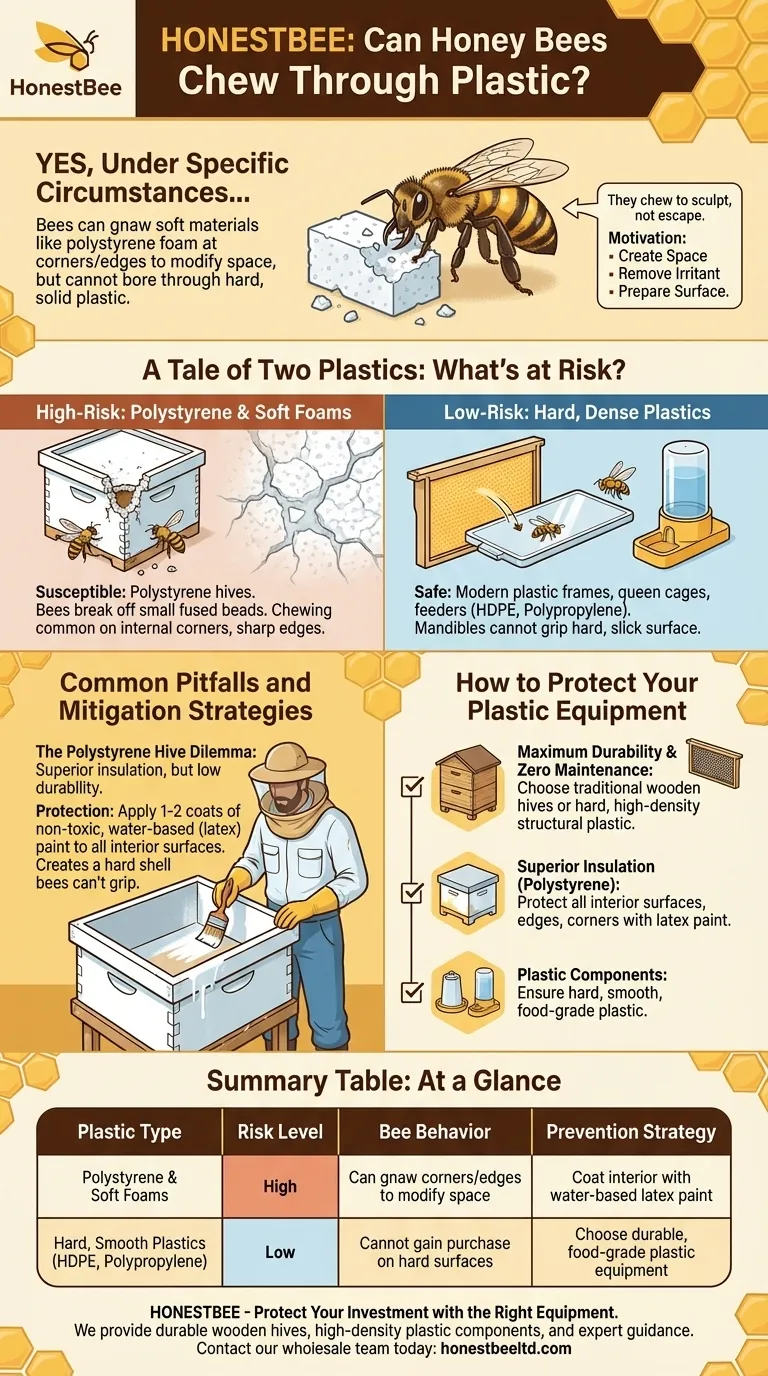Yes, under specific circumstances, honey bees can and do chew certain types of plastic. Their ability to do so, however, is highly dependent on the material's density and texture. They cannot bore through hard, solid plastic, but they can easily gnaw and remove softer materials like polystyrene foam, particularly at corners and edges, to modify their living space.
The core distinction is one of intent and capability. Honey bees chew to sculpt their environment, not to escape or consume. They can effectively damage soft, foam-like plastics but lack the ability to penetrate hard, smooth plastic surfaces.

The Motivation: Why Bees Chew Plastic
Honey bees use their powerful mandibles (jaws) for a variety of in-hive tasks, from building comb to removing debris. When they direct this behavior toward plastic, it is almost always for one of three reasons.
To Create or Adjust Space
Bees are meticulous architects that adhere to the principle of "bee space"—a gap of roughly 6-9mm that they prefer to leave open as a passageway. If a piece of soft plastic infringes on this space, they may chew it away to restore their preferred hive geometry.
To Remove an Obstacle or Irritant
Bees are hygienic and will attempt to remove any foreign or unwanted material from their hive. A loose sliver of soft plastic or a rough surface can be perceived as an irritant, prompting them to gnaw at it until it is removed or smoothed over.
To Prepare a Surface
Bees often prefer a rougher texture to help propolis and wax adhere properly. They may chew on a perfectly smooth plastic surface to create a better foothold for their own construction materials.
A Tale of Two Plastics: What's at Risk?
Not all plastics are created equal in the eyes of a honey bee. The material's hardness and structure are the determining factors in its vulnerability.
High-Risk: Polystyrene and Soft Foams
This is the most common type of plastic damaged by bees. Polystyrene hives, valued for their excellent insulation, are highly susceptible. The material is essentially a collection of small, fused beads that bees can easily break off one by one with their mandibles.
Chewing is most common on internal corners, entrance reducers, and any sharp edge within the hive.
Low-Risk: Hard, Dense Plastics
Hard, smooth plastics are generally safe from bee mandibles. This includes most modern plastic hive frames, queen cages, and many types of feeders made from food-grade polypropylene or high-density polyethylene (HDPE).
The bees' mandibles simply cannot gain purchase on the hard, slick surface to begin the chewing process.
Common Pitfalls and Mitigation Strategies
Understanding the risk allows for effective prevention, particularly for those using polystyrene equipment.
The Polystyrene Hive Dilemma
Beekeepers choose polystyrene for its superior thermal properties, which can lead to healthier, more productive colonies. This benefit comes with the trade-off of lower durability against the bees themselves.
Leaving the interior surface of a polystyrene hive unprotected is a common mistake that will inevitably lead to damage.
Protective Measures that Work
The most effective strategy to prevent bees from chewing polystyrene is to create a barrier they cannot penetrate.
Applying one or two coats of non-toxic, water-based (latex) paint to all interior surfaces is the industry-standard solution. The paint dries into a hard, smooth shell that the bees' mandibles cannot grip, effectively protecting the softer foam underneath.
How to Protect Your Plastic Equipment
Your approach should be dictated by the type of equipment you are using and your goals as a beekeeper.
- If your primary focus is maximum durability and zero maintenance: Choose traditional wooden hives or those made from hard, high-density structural plastic, which are impervious to chewing.
- If your primary focus is superior insulation using polystyrene hives: You must protect all interior surfaces, edges, and corners with a coat of non-toxic, water-based latex paint before introducing your bees.
- If you are using plastic frames, feeders, or queen excluders: Ensure they are made from hard, smooth, food-grade plastic, as bees are highly unlikely to cause any damage to these components.
Ultimately, managing your equipment effectively comes down to understanding the specific material and the bees' motivation.
Summary Table:
| Plastic Type | Risk Level | Bee Behavior | Prevention Strategy |
|---|---|---|---|
| Polystyrene & Soft Foams | High | Can gnaw corners/edges to modify space | Coat interior with water-based latex paint |
| Hard, Smooth Plastics (HDPE, Polypropylene) | Low | Cannot gain purchase on hard surfaces | Choose durable, food-grade plastic equipment |
Protect Your Investment with the Right Equipment
As a commercial beekeeper or distributor, hive durability directly impacts your bottom line. At HONESTBEE, we supply beekeeping equipment designed to withstand natural bee behaviors while maximizing productivity.
We provide:
- Durable wooden hives that are naturally chew-resistant
- High-density plastic components that bees cannot damage
- Expert guidance on protecting polystyrene equipment
Let us help you select the right supplies for your operation. Contact our wholesale team today for bulk pricing and equipment recommendations tailored to commercial apiaries.
Visual Guide

Related Products
- Plastic Bee Hive Stand for Beekeeping
- HONESTBEE Advanced Ergonomic Stainless Steel Hive Tool for Beekeeping
- Yellow Plastic Bucket Pail Perch for Beekeeping
- Professional Dual-End Stainless Steel Hive Tool for Beekeeping
- Beehive Handle and Frame Rest Cutting Machine: Your Specialized Hive Machine
People Also Ask
- What are the main differences between Langstroth and Top Bar Hive designs? Choose the Right Hive for Your Beekeeping Goals
- What are the advantages of a second hive if the queen is killed? The Ultimate Insurance Policy for Your Apiary
- How do bees regulate the temperature of their hive during the summer? Discover Their Natural Cooling System
- What is the purpose of a hive stand in a Langstroth hive? Protect Your Hive and Boost Colony Health
- How do bees regulate ventilation and temperature in the hive? Master Hive Climate Control



















